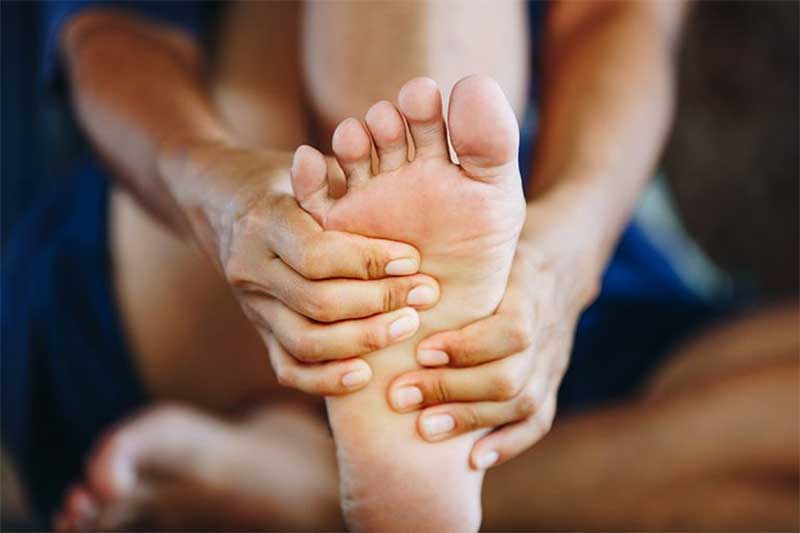
By Kiersten Hickman
Not sure if it’s time to change those shoes? Doctors of Podiatry Medicine share some of the common symptoms they see from a poor pair of shoes, and how it’s negatively affecting your feet.
Did you know your shoes should be replaced every six to 12 months? It may sound excessive, but many podiatrists would argue that your health will pay the price if you’re not going to pay for a new pair. An old or poorly made pair of shoes can affect not only your foot health, but will also take a significant toll on your posture and even increase your risk of injury.
But how do you know when it’s time to replace the pair you are wearing? While foot pain is a clear symptom of needing a new pair, there are actually numerous other warning signs to look for that may not be as overt.
Your shoes are falling apart
“If you notice that your shoes are wearing down unevenly, or if they seem to be falling apart quicker than usual, it’s a good indication that they’re not well-made and are causing you harm,” says Daniel Pledger, DPM, podiatrist and founder of ePodiatrists.
Because your foot is constantly coming in contact with the sole of your shoe every time you take a step, your shoe will slowly start to experience wear and tear. If the shoe is poorly made with cheap materials and insufficient foot support, your shoe will likely fall apart quickly because of frequent use. So if your shoe is falling apart, it’s time to replace it with something new made with quality materials.
You’re experiencing pain in your feet, knees, and lower back
Your shoes play a significant role not just in the health of your feet, but posture and mobility as well.
“If you’re experiencing pain in your feet, knees, or lower back, it could be a sign that your shoes are not giving you the support you need,” says Dr. Pledger.
One study published in the Journal of Food and Ankle Research actually found that foot pain and foot disorders can actually be a result of incorrectly sized shoes. Between 63% and 72% of participants were wearing shoes that did not accommodate either the width or length of their feet, causing pain and disorders such as lesser toe deformity, corns, and calluses.
You’re constantly fiddling with your shoes
Even if a shoe that is a touch smaller than normal may not seem like a big deal, over time the shoes can cause discomfort, which can lead to fiddling and readjusting.
“If you have to constantly adjust your shoes or re-tie them throughout the day, it means they don’t fit properly and are likely causing you discomfort,” says Dr. Pledger.
In some cases, shoe width plays a major role when it comes to foot pain and discomfort. Another study published by the same journal found that participants wore narrower shoes than what may be recommended by a podiatrist, which can cause discomfort.
You’re getting blisters
Blisters aren’t just a result of breaking in a pair of shoes but can be a major sign that your shoes aren’t doing you any favors.
“Blisters are always a telltale sign,” says Dr. Suzanne Levine, DPM, RPT, PC, a New York-based aesthetic podiatrist and board-certified podiatric foot surgeon.
Blisters occur when the skin of your foot is rubbing against your shoe, causing your skin cells to separate and fluid to build up in its place due to the consistent friction. While some of this will happen when trying to break in a pair of shoes — which tend to be stiff — if your shoes continue to give you blisters after breaking them in, it’s a sign that this isn’t a particularly good pair for you.
Your feet are red
Dr. Levine says if you’re experiencing “redness on toes, hammertoes, corns, irritations, especially in the forefoot (the balls of the foot, just under the toes),” it’s likely a result of a poor pair of shoes.
Foot redness can be a sign of many different health issues, like infection and inflammation. But redness can also be a sign of a poor pair of shoes. Shoes that are too tight could result in athlete’s foot, a fungal infection that can occur if sweaty feet are confined to a tight pair. Tight shoes can also cause foot redness due to decreased blood flow to the feet, which can result in cramping and pain.
How to know when it’s time to replace your shoes
“If you wear a pair of shoes a lot — they are your go-to’s, wear with every outfit, throw on to take the dog out-type shoes — they should be replaced yearly; possibly sooner depending on the quality,” says Dr. Levine. “Orthotics should also be replaced at least once a year.”
Podiatrists will also recommend shoe inserts to numerous patients for better foot support, but even those need to be replaced just as frequently.
“If you’re using an insert for support, make sure to check it regularly and replace it as needed,” says Dr. Pledger. “A good rule of thumb is to replace it every three to six months.”
Dr. Levine also says that if you are a runner, running shoes should be replaced every 4 to 6 months depending on use. Many podiatrists also recommend replacing your running shoes after running 300 to 500 miles max. (https://www.thehealthy.com/foot-care/signs-shoes-are-ruining-your-feet/)






















